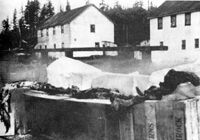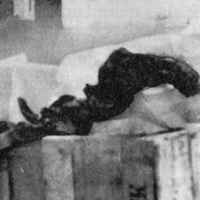Cadborasorus

Cadborosaurus Willsi
By Aaron Justice
Off the British Colombian coast of Cadboro Bay lives a monster, affectionately named Caddy or Cadborosaurus Willsi. It is described as a long, serpent like beast with flippers, hair on the neck, and a camel like head. It could be anywhere from 40 to 70 feet long in length. The monster has been seen less than 100 times in the last 60 years, but the sightings remain consistent and precise unlike sightings of the Loch Ness monster and Ogopogo in which sightings vary due to misidentification. Ogopogo has been described as having "a dark brownish-gray skin like texture" to "bluish-green-gray" scales. Yet all the sightings of Caddy remain consistent, usually because it was visible long enough to get an accurate description.
The Effingham Carcass, Vancouver Island, 1947.
Photo is Public Domain.
The Fircom carcass, washed up at Camp Fircom,
British Columbia, October 4 1936. Photo is Public Domain.
The first reported sighting of Caddy was in 1933 by a Victoria lawyer and his wife on a cruise in their yatch. They described a "horrible serpent with the head of a camel." This is generally what every sighting of the beast is like. The creature showed itself again in 1934 when two members of the Provincial Government reported seeing the creature, the same description as the first. Later that same year two fishermen saw TWO monsters in the bay, one about 60 feet long, the other half that size. A rather interesting sighting was made by two hunters as they tried to recover their wounded duck. The monster rose out of the water, swallowed the duck, snapped at some gulls then submerged. They noted the six-foot long head with saw-like teeth.
The body of a possible Cadborosaurus found in the body
of a sperm whale. Used by permission of the BCSCC.
Closeup of the head.
It was in 1937 that a photograph of Caddy was obtained. A whaling station in Vancouver just caught and killed a sperm whale in October of 1937. While removing the stomach contents at the Naden Harbor whaling station they came across a twenty-foot long carcass of an unidentified creature. It had the head of a horse, a snake-like body and a finned, spiny tail. A photograph was taken, but no one knows exactly what happened to its remains. No scientist can properly identify the creature in the photograph. It seems to have mammalian and reptilian traits, but which it is, no one is sure of. It is suggested that the creature is a Zeuglodon, but that explanation isn't 100% satisfactory seeing that it is much slimmer and the head is shaped improperly.
Perhaps the closest sighting of Caddy was taken in 1939 by Captain Paul Sowerby.
"We were headin' North, and, about thirty miles offshore, and saw this thing standing about four feet out of the water. So, I headed over towards it and took a look at it. At first, I thought it looked like a polar bear with its ruffles of hair. When we got right up alongside of it-and the water was crystal clear-there was just this column of this thing going at least forty feet and huge eyes. I had an old Newfoundlander as a mate and he said 'Do you see eyes on him?' Mouth and nose I have no recollection of at all, just those great big eyes. And the eyes seemed to open from top to bottom."
The sightings did not stop in the 30's, it continued into the 50's when ten people saw him on February 13, 1953. All of them watched it from different points of view and not one of the descriptions contradicted each other. The sightings continued into the 80's, but the sightings slimmed down considerably. Perhaps the creature had moved on, looking for warmer waters more plentiful with fish. They could also have died; perhaps the young were eaten by whales that frequent the coast. The real question is not where they have gone, but what they are.
The Head of Caddy, by Alisa Stern.
The descriptions place Caddy as some sort of a mammal, long, slender, and with a bifurcated tail. This suggests that it is a Zeuglodon, an ancient whale thought to be extinct. The only problem is that the head of the creature is described as a camels or a horses, while a Zeuglodon, or Basilosaurus, head is more like that of a snakes. The monster of Lake Okanagon, known as Ogopogo, is believed to be a Zeuglodon, but the sightings are different of that of Caddy. It never raises its neck, nor does it have hair, nor is the head camel-like, it is more like that of a snake. My belief is that Caddy is a relative of the Zeuglodon, longer but slimmer. If we only had the body that was found we would have a good idea of what it was, but until another one shows up we will always have an unknown creature on our hands.
Selected Sources:
Monsters of the Sea by Richard Ellis
Roesch, Ben S. "Cryptozoology: Searching for Hidden Animals" (http://www.ncf.carleton.ca/~bz050/HomePage.cryptoz.html)
The Wake of Sea Serpents by Bernard Heuvelmans
http://www.seanet.com/~daveco/
